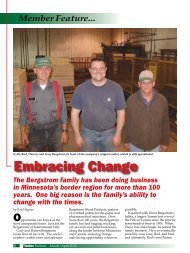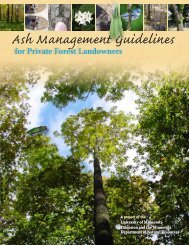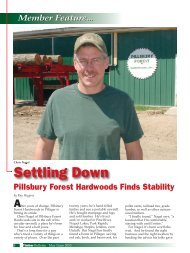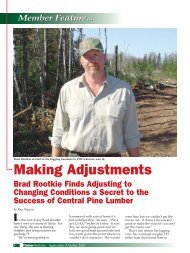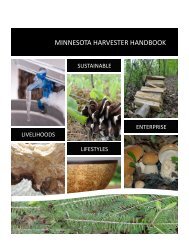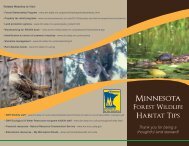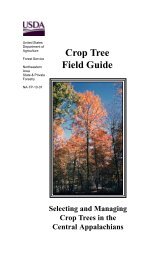Ash Management Guide for Private Forest Landowners
Ash Management Guide for Private Forest Landowners
Ash Management Guide for Private Forest Landowners
You also want an ePaper? Increase the reach of your titles
YUMPU automatically turns print PDFs into web optimized ePapers that Google loves.
Chapter 5The Native PlantCommunitiesWet <strong>Forest</strong> System<strong>Ash</strong> in the Wet<strong>Forest</strong> SystemGLOSSARYpure stands: <strong>Forest</strong>, crop, orstand composed principally ofone species, conventionally atleast 80 percent based onnumbers, basal areas, orvolume.Red-osier dogwood isan indicator of the Wet<strong>Forest</strong> System.The range(blue) of Wet<strong>Forest</strong>s inMinnesota andthose that includeash (dots).Wet <strong>Forest</strong> (WF) communities occurcommonly in narrow zones along themargins of lakes, rivers, and peatlands;they also occur in shallow depressionsor other settings where the water table iswithin reach of plant roots. The suppliesof groundwater and runoff typically areat their peak early in the spring and thendiminish throughout the growing season.The contribution of runoff to these systemsis greatest in northeastern Minnesota;it lessens in the southwest to the pointwhere wet <strong>for</strong>ests there are fed entirely byupwelling groundwater. Black ash acts likea hydrologic pump, lowering the watertable as summer progresses. The seasonalvariability in soil moisture is a hallmarkof the WF System. This variability controlsthe availability of the oxygen.This oxygen is essential <strong>for</strong>:• roots to respire;• decomposition of organic litter; and• release of nutrients in <strong>for</strong>ms that areusable by plants.This physical environment is problematic<strong>for</strong> most of Minnesota’s trees,except <strong>for</strong> ash and northern white cedar.Consequently, it is specifically these twospecies: ash and white cedar, that tendto dominate WF sites. Oftentimes, theyare found as pure stands of those species.All plant communities designatedas “WF” sites have some ash regeneration,and over 75% have ash trees in thecanopy. Black ash is the WF specialist,occurring in 69% of all wet <strong>for</strong>ests, andthe average stand is 36% black ash trees.Common Trees:• Black ash• Northern white cedar• Green ash• Balsam firPhoto: Paul Wray/Iowa State University, Bugwood.org32



